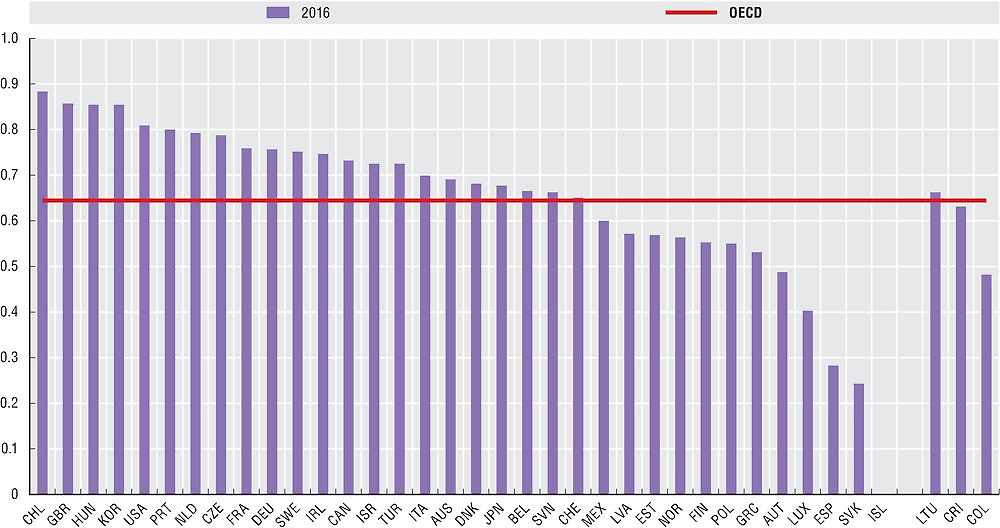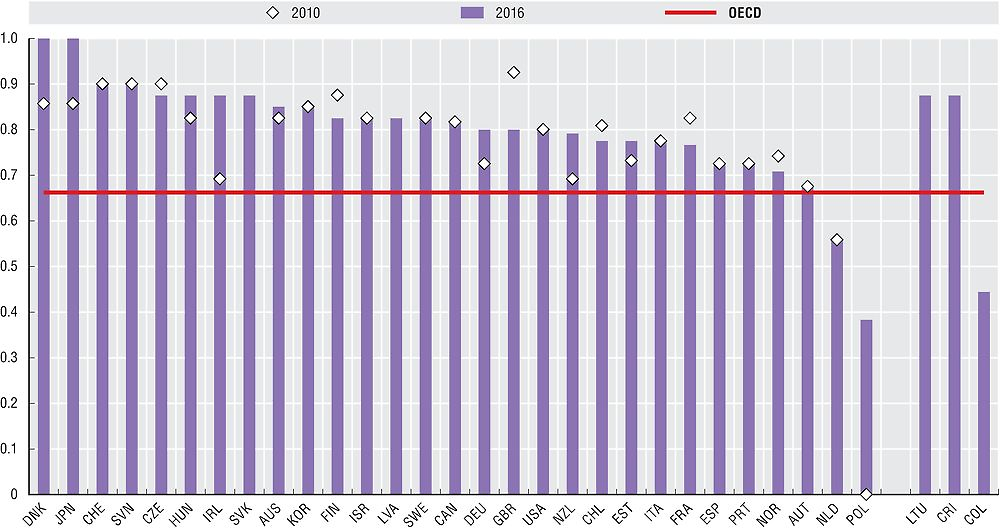Staff performance management
Improving public service quality, accessibility and responsiveness, while carefully managing limited resources, requires effective performance management in the public sector. Defining appropriate performance indicators for policies and services can inform the performance objectives of employees. Such practices help to clarify organisational goals for staff so that they gain a better understanding of their role within the organisation and how to best contribute towards strategic organisational objectives. Performance assessments also strengthen incentives to improve performance by allowing for the recognition of individual and collective efforts in a consistent and transparent manner. Performance assessments can help to identify gaps in skills and can feed into strategic HR planning and training.
Today, almost all OECD countries have formal performance assessments that are mandatory for central government employees. The composite indicator assesses the use of performance assessments to inform HR decisions, including formal requirements, tools used and implications of performance assessments for employees. Chile and the United Kingdom integrate performance assessments into their HR decision making to a greater extent than other OECD countries. Conversely, Spain and Iceland do not conduct mandatory formalised performance assessments for employees, while in Norway and the Slovak Republic they are conducted for some staff only. Some 16 OECD countries have identified employee performance management as an area of current reform. New performance management systems have recently been implemented in Canada and Ireland. Canada has standardised a single system across the entire federal public service, while Ireland has simplified their assessments to a two-point scale: satisfactory or not.
Relating performance assessment results to rewards for staff remains a challenging issue in many OECD countries. Performance incentives include career opportunities (such as promotions) and pay. The use of performance-related pay (PRP) in the form of bonuses (18 countries) or performance-based permanent pay increases (21 countries) has been relatively stable since the survey was last conducted in 2010. PRP can vary according to the range of staff positions to which it applies, whether the targets and the incentives apply to individuals or to groups, the extent to which rankings are used, and the size of awards. Denmark and Japan use PRP more extensively than other countries. Both countries apply PRP to most government employees through a combination of one-off performance bonuses and performance-based permanent pay increases. In these cases, PRP can amount to over 40% of an employee’s base salary. In Poland, on the other hand, PRP is only used for specific professions. Belgium, Greece, Iceland, Luxembourg, Mexico, and Turkey report not using PRP at all.
Data refer to 2016 and 2010 and were collected through the 2016 and 2010 OECD Survey on Strategic Human Resources Management. Respondents were predominantly senior officials in central government HRM departments, and data refer to HRM practices in central government. In 2016, the survey was completed by all OECD countries, as well as the OECD accession countries Colombia, Costa Rica and Lithuania. Definitions of the civil service as well as the organisations governed at the central level of government differ across countries and should be considered when making comparisons. The terms public and civil service/servants are used interchangeably throughout this chapter.
The index on performance assessment is composed of the following variables: existence of a formalised performance assessment; use of performance assessment tools; performance assessment criteria; and importance of performance assessment for career advancement, remuneration, and contract renewal. The index on PRP is composed of the following variables: use of a PRP mechanism and for which staff categories; use of one-off bonuses and/or merit increments; and maximum proportion of basic salary that PRP represents.
Indices range between 0 (no use) and 1 (high use). Missing data were estimated by mean replacement. Indices provide information on the formal use of performance assessments and PRP in central government, but do not provide any information on their implementation or on the quality of work performed.
See the Annex online for further country-specific information as well as details on the methodology and factors used in constructing the index. The variables composing the index and their relative importance are based on expert judgements. They are presented with the purpose of furthering discussion, and consequently may evolve over time. Comparisons between the index on performance assessment from Government at a Glance 2011 and 2017 should be made with caution, as weightings and the number of country responses vary.
Further reading
OECD (2016), Engaging Public Employees for a High-Performing Civil Service, OECD Publishing, Paris.
Figure notes
6.3 Data not included for New Zealand.
6.4 The average for OECD countries includes the six OECD countries that have reported not having a PRP system: Belgium, Greece, Iceland, Luxembourg, Mexico and Turkey.
Information on data for Israel: https://doi.org/10.1787/888932315602.

Source: OECD (2016), Strategic Human Resources Management Survey, OECD, Paris.

Source: OECD (2016, 2010), Strategic Human Resources Management Survey, OECD, Paris.
